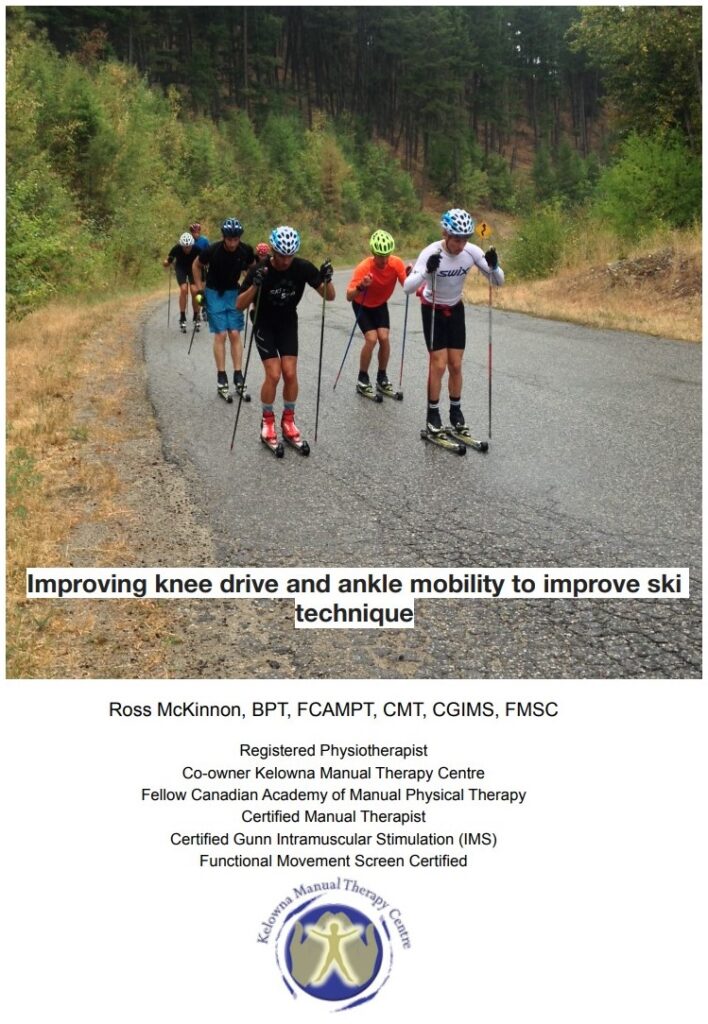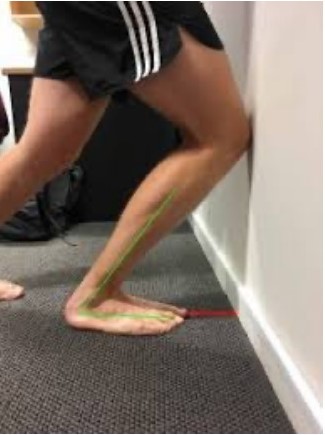
Improving knee drive and ankle mobility to improve ski
technique
Modern classic and skate ski techniques require a large degree of
ankle flexibility. Athletes commonly do not have adequate ankle
mobility to attain optimal technique, especially while growing.
If an athlete does not have enough ankle mobility they are forced
to keep their shin (tibia/Fibula) vertical while skiing i.e. they lack
knee ‘drive’. This lack of ankle mobility also results in the hips
staying backwards over the ankles. A lack of ankle mobility can
also cause the knees to turn inwards while flexing.
What is the best method to improve the ankle mobility
required to improve ‘knee drive’ and body position?
By focusing on eccentric (lengthening) exercises athletes can
improve both mobility and strength in their ankles. The lack of
ankle range of motion is a compensation for lack of calf muscle
strength and muscle ‘control’. In other words the stiffness is a
result of inadequate strength and control through the required
range of motion. The muscle is forced to stiffen up as it cannot
generate force through the full range of motion.
Achieving a correct ankle and knee position also requires
considerable quadriceps strength.
Recent research studies have shown that eccentric exercise is
more beneficial than static stretching to improve muscle flexibility
throughout the body. Two studies have demonstrated an increase
in ankle mobility and improvement of muscle ‘elasticity’ using
eccentric exercise.
Benefits of eccentric exercise
Improve ankle mobility
Improve strength through the entire ankle range of motion
Improve ability to absorb ‘loading’ i.e. injury prevention.
Negatives:
Caution to not over fatigue an athlete, the exercise should be
performed on strength days or 2-3 time weekly.
Eccentric exercise will increase delayed onset muscle soreness
(DOMS).
Caution: ensure that athletes do not feel any pain or tightness in
the front of their ankle. Pain in the front of the ankle should be
assessed by a physiotherapist.
Measuring Ankle Range of Motion
The easiest way to quantify ankle dorsiflexion ROM is with a tape
measure. This method utilizes the knee-to-wall measurement, in
which the subject performs a weight-bearing lunge. The athlete
places the test foot on a tape measure perpendicular to the wall
and lunges forward so the knee touches the wall. The foot is
moved away from the wall until the knee can only make slight
contact with the wall. The heel must remain flat on the ground.
This test position places the ankle in maximal dorsiflexion, and
the distance from the great toe to the wall is measured in
centimetres, with each centimetre corresponding to approximately
3.6° of ankle dorsiflexion.
Range of motion measured in weight bearing with the ankle flexed
is between 33-50 degrees in a non-athletic population (depending
on the study). This would translate to between 9-13cm of ankle
bend. Of course individual body type will influence range of
motion and should be used to show athletes their improvement
not compared to others.
This method is inexpensive, reproducible, can be performed in a
variety of settings, and does not require the technical proficiency
associated with with other measurements. The tape measure
method is also more sensitive to change compared to measures
of motion in degrees. This position is very functional for cross
country skiers as it reproduces the ski position where maximal
ankle mobility is required.
Measurement can be reformed at monthly intervals to check
progress, athletes can also measure their own progress with tape
on the floor at their maximum.

The Eccentric Exercise regimen:
Stair heel drops
Exercise 1
The knee should stay straight, but not ‘locked backwards’
throughout the exercise. The ‘ball’ of the foot will balance on the
stair. The athlete will rise up onto the ball of the foot and toes
over 3 counts (concentric) then lower to a maximal stretch over 3
counts (eccentric).
The exercises should be repeated to muscular fatigue and can be
progressed from body weight to increased weight either using a
weighted calf machine or weights in backpack.
Exercise 2
The knee should be flexed around 20 degrees throughout the
exercise. The ‘ball’ of the foot will balance on the stair. The
athlete will rise up onto the ball of the foot and toes over 3 counts
(concentric) then lower to a maximal stretch over 3 counts
(eccentric).
Athletes will typically fatigue much more quickly with this exercise
than with the knee straight. This is also the exercise that will
focus on calf strength with the knee bent which is the functional
position for initiating push off after preload.
It is a good idea to check for right to left strength differences, and
make note of the asymmetry.
The exercises should be repeated to muscular fatigue and can be
progressed from body weight to increased weight either using a
calf machine, holding a weight in one hand, or putting weights in a
backpack.
Aim for 3 sets of 15 reps on strength training days, or 2-3 time
weekly.
REFERENCES:
Duclay J, Martin A, Duclay A, et al. Behavior of fascicles and the
myotendinous junction of human medial gastrocnemius following
eccentric strength training. Muscle Nerve 2009;39:819–27.
Mahieu NN, McNair P, Cools A, et al. Effect of eccentric training
on the plantar flexor muscle-tendon tissue properties. Med Sci
Sports Exerc 2008;40:117–23



